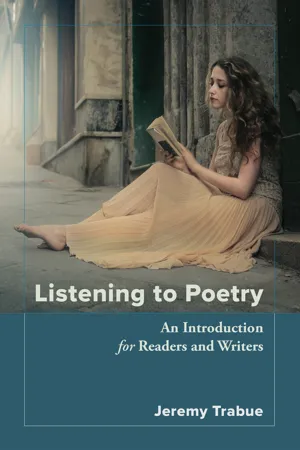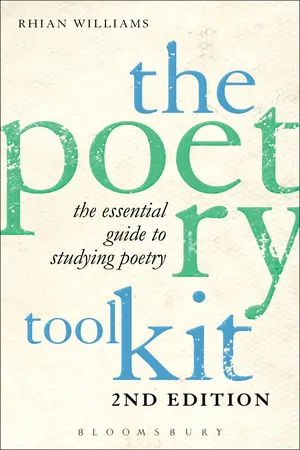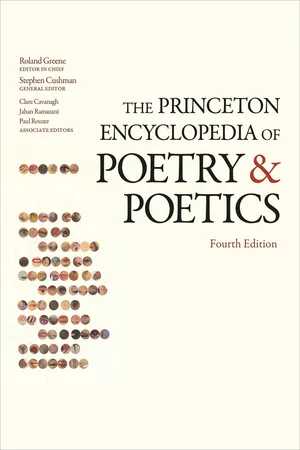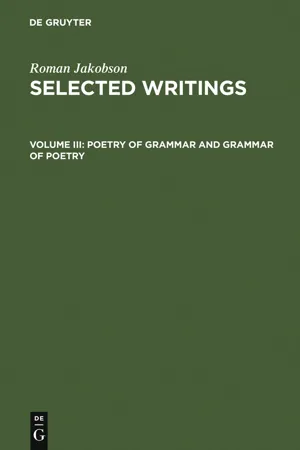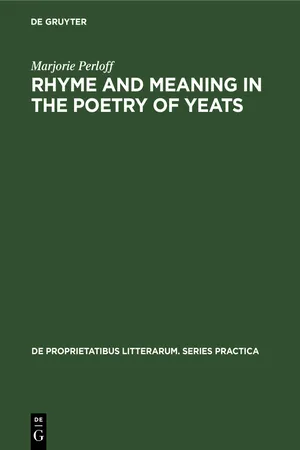Languages & Linguistics
Feminine Rhyme
Feminine rhyme is a type of rhyme where two syllables are rhymed, with the stress falling on the second-to-last syllable in each word. This type of rhyme is often associated with a more delicate or "feminine" sound, and is commonly used in poetry. Examples of feminine rhyme include words like "butter" and "clutter," where the final syllables "er" and "er" rhyme.
Written by Perlego with AI-assistance
6 Key excerpts on "Feminine Rhyme"
- Available until 18 Jan |Learn more
Listening to Poetry
An Introduction for Readers and Writers
- Jeremy Trabue(Author)
- 2019(Publication Date)
- Chemeketa Press(Publisher)
Single rhymes are often called masculine, while multiple rhymes are often referred to as feminine. These terms don’t have anything to do with human genders. They derive from French poetry jargon and ultimately from the grammar of Latin, in which words are classified according to gender as a linguistic concept. Feminine Rhyme is used in some comic verse forms, such as the limerick, and some people think of it as inherently comical. However, plenty of poems that don’t even crack a smile are written using Feminine Rhyme.Some people use the terms “Feminine Rhyme” and “masculine rhyme” more restrictively, not only distinguishing number of rhyming syllables but the relationship between the rhyming syllables and whether or not they are stressed.We don’t need to worry about those, or the many other, labels given to other types and sub-types of rhyme, but it’s worth considering how the interactions of stress and rhyme create variety and might impact how we hear and appreciate a poem. In the following rhyming word pairs, the stressed syllables are in bold, and the rhyming syllables are underlined :Singlebay / weigh —A stressed syllable is rhymed with aRhymesstressed syllable. la • dy / tab • by —An unstressed syllable is rhymed with an unstressed syllable.wing / ask • ing —A stressed syllable is rhymed with an unstressed syllable.Doubleab • bey / tab • by —The double rhyme starts with aRhymestressed and ends with an unstressed syllable. Tripleu • ni • fy • ing / tes • ti • fy • ing —the triple rhymeRhymestarts and ends with an unstressed syllable; the stressed syllable is between them. Most people find the rhymes in which a stressed syllable at the end of a word rhymes with a stressed syllable at the end of another word to be the “strongest”—clearest, most obvious. Rhymes like “lady / tabby,” on the other hand, may not feel like “real” rhymes at all to some. The final syllables have the exact same sound, but the initial syllables don’t. Those initial syllables are where the stress falls in each word, emphasizing the difference of those two syllables rather than the sameness of the final, rhyming syllables. This makes some people wonder if these are “real” rhyme. In short, the answer is yes. These differences may not seem important or even evident to you, but keep them in mind when analyzing the rhyme scheme of a poem. - eBook - PDF
- Rhian Williams(Author)
- 2013(Publication Date)
- Bloomsbury Academic(Publisher)
Indeed, rhyme can mirror how we gather experience and knowledge: patterns are spotted, but then frequently reappear in slightly altered ways; as Mark Twain is said to have quipped, ‘History doesn’t repeat itself, but it does rhyme’. While we might be keen to identify rhyme schemes , it is important to be alert to the precise dynamics at play in each individual instance of rhyme. Therefore discussion of rhyme scheme is deferred until the end of this chapter. Note that where rhymes are pointed out in examples here they are italicized . Reference Wimsatt, W. K., ‘One Relation of Rhyme to Reason’, in The Verbal Icon: Studies in the Meaning of Poetry (Kentucky: University Press of Kentucky, 1954), pp. 153–68. 4.1 Perfect rhymes Perfect rhyme When the sounds of two words match exactly, usually by repeating the main stressed vowel and any consonants following it. Perfect rhymes are the most obvious and familiar of rhymes, and the ones we recognize in everyday speech around us as well as in poetry. They are often labelled according to the number of syllables involved in the rhyme: � l Masculine rhyme : rhymes of one stressed syllable Example: reach and speech � l Feminine Rhyme : rhymes of two syllables that end on an unstressed note Example: yellow and fellow � l Triple rhyme : rhymes involving three syllables Example: greenery and scenery. The Poetry Toolkit 168 As English verse is often iambic , so ending on a stressed syllable, masculine rhymes emphasize the heavy ends of lines. They might create a particularly sombre effect, with each single-syllable rhyme tolling like a bell, as in Donne’s defiant address of death: Death be not proud, though some have called thee Mighty and dreadfull, for, thou are not soe, For, those, whom thou think’st, thou dost overthrow, Die not, poore death, nor yet canst thou kill mee; John Donne, ‘Holy Sonnet X’ (1633), ll. - eBook - PDF
Studies in the History of the English Language
A Millennial Perspective
- Donka Minkova, Robert Stockwell, Donka Minkova, Robert Stockwell(Authors)
- 2008(Publication Date)
- De Gruyter Mouton(Publisher)
Finally in section 4 I briefly note some ways in which the vowel differences found in Pope’s rhymes in “The Rape of the Lock” diverge from those in Shakespeare, in order to show that the historical issues raised by variation in rhyme are not only synchronic ones about literary language of the past, but also true diachronic ones of how poetic forms are transmitted within a tradition. 2. The rhetoric of partial rhymes 2.1 Defining “partial rhyme” The array of conflicting terminology used in relation to rhyme necessitates a comment on how terms are used here. Loosely speaking, rhyme involves the occurrence for poetic purposes of the same sounds at the ends of dis-crete stretches of language. Describing it more formally involves specify- 210 Kristin Hanson ing where those stretches of language are located in a text, which parts of them are repeated, and how complete the repetition is. In English, the ca-nonical form of rhyme as a structural device in poetry – indeed its defini-tion for many – involves the syllables in the final strong metrical position of discrete lines, and requires the nuclei of those syllables and all segments following to the end of the line to be identical. The issue of location, inter-esting though it is across the tradition, will not be of concern here; all the rhymes considered are end-rhymes in the canonical location, as in (1) and (2). What is trickier is the interrelationship of the other two issues, for the fundamental subject here is whether and if so how the nuclei of those syl-lables may be implicated in some relationship of repetition, and yet not be identical. The necessary distinction is carefully expressed by Rickert (1978), who reserves the term “rhyme” for the form in which requirements of repetition are imposed on the nuclei of rhyming syllables as well as what follows, as opposed to “slant rhyme”, in which requirements of repetition are imposed on the final consonant only. - eBook - ePub
The Princeton Encyclopedia of Poetry and Poetics
Fourth Edition
- Stephen Cushman, Clare Cavanagh, Jahan Ramazani, Paul Rouzer, Stephen Cushman, Clare Cavanagh, Jahan Ramazani, Paul Rouzer(Authors)
- 2012(Publication Date)
- Princeton University Press(Publisher)
One other way of approaching this issue, however, is to point out that rhyme depends less on the structure of the lang. than on the semantic field presently relevant in the poem: only some of the available rhymes for a given word are possible candidates for use in a poem on a given subject. What this means, most generally, is that it is dangerous to discuss rhyme as an abstract entity divorced from the constraints imposed on it in each individual poem. The subject of morphology and rhyme is a large and complex one that still remains to be mapped out.(3) By the position of the stress on the rhyming (and adjacent) syllables. Normally, single rhymes are ictic and stressed; double rhymes add an extra unstressed syllable. Rhyming masculine with feminine words, i.e., a stressed monosyllable with a disyllable the rhyming syllable of which is unstressed (e.g., sing / loving , free / crazy , afraid / decade ) Tatlock called “hermaphrodite” rhyme (an odd term, since male mating with female in love would not be thought so). Others have called it “apocopated” or “stressed-unstressed” rhyme; it was popular in the 16th and 17th cs. and is used by John Donne and by Ezra Pound (Hugh Selwyn Mauberley ). There is also “unstressed rhyme,” where the rhyming syllables are both unstressed or weak: e.g., honey / motley , mysteries / litanies , wretchedness / featureless . But there is some question whether this constitutes rhyme at all. Scherr calls all such cases in Rus. poetry “heteroaccentual” forms and cites the taxonomy given by Markov.A related type rhymes a stressed syllable with one bearing only secondary speech stress, which is promoted under metrical ictus, e.g., sees / mysteries . Many rhyme pairs of this sort formerly differed in pronunciation and were good rhymes in their time, though they are not now; others were not so, then as now. Rhymes like eye / harmony , eye / symmetry (William Blake), or flies / mysteries force the critic to call on the researches of historical phonology.Perhaps the most interesting case of all is the pair die / poetry , common in the Ren. There is some evidence (e.g., Alexander Gill in Logonomia Anglica , 1620) that, for words like poetry , alternative pronunciations existed as late as the first quarter of the 17th c., one form pronounced as the word is today, to rhyme with me , the other to rhyme with die . If so, rhyme pairs like poetry / die —and others like majesty / eye , crie / graciously , and most others ending in ty or ly —may well have been good rhymes for Shakespeare and the Ren. sonneteers, as they were for John Milton. But the diphthongal ending apparently lost out, so that sometime after 1650 poetry and die - eBook - PDF
- (Author)
- 2010(Publication Date)
- De Gruyter Mouton(Publisher)
If a poet tends to avoid grammatical rhymes, for him, as Hopkins said, There are two elements in the beauty rhyme has to the mind, the likeness or sameness of sound and the unlikeness or difference of meaning. 39 Whatever the relation between sound and meaning in different rhyme techniques, both spheres are necessarily involved. After Wimsatt's illuminating observations about the meaningfulness of rhyme 40 and the shrewd modern studies of Slavic rhyme patterns, a student in poetics can hardly maintain that rhymes signify merely in a very vague way. Rhyme is only a particular, condensed case of a much more general, we may even say the fundamental, problem of poetry, namely parallelism. Here again Hopkins, in his student papers of 1865, displayed a prodigious insight into the structure of poetry: The artificial part of poetry, perhaps we shall be right to say all artifice, reduces itself to the principle of parallelism. The structure of poetry is that of continuous parallelism, ranging from the technical so-called Parallelisms of Hebrew poetry and the antiphons of Church music up to the intricacy of Greek or Italian or English verse. But parallelism is of two kinds necessarily — where the opposition is clearly marked, and where it is transitional rather or chromatic. Only the first kind, that of marked parallelism, is concerned with the structure of verse — in rhythm, the recurrence of a certain sequence of syllables, in metre, the recurrence of a certain sequence of rhythm, in alliteration, in assonance and in rhyme. Now the force of this recurrence is to beget a recurrence or parallelism answering to it in the words or thought and, speaking roughly and rather for the tendency than the invariable result, the more marked parallelism in structure whether of elaboration or of emphasis begets more marked parallelism in the words and sense. - eBook - PDF
- Marjorie Perloff(Author)
- 2019(Publication Date)
- De Gruyter Mouton(Publisher)
My definition, which is based on Webster's Third, is, I believe, a more useful one than Herbert's for, according to his definition, one would have to label such common Feminine Rhymes as let us/get us mosaic-rhymes. The word mosaic more appropriately fits a rhyme in which a single word is rhymed with more than one word, as in take it/naked. 32 THE PHONETIC FUNCTION OF RHYME IN YEATS'S POETRY language than are the other three degrees of stress. It occurs chiefly when a compound noun rhymes with a simple noun, as in the following example from The Rose of Peace (22): If Michael, leader of God's host When Heaven and Hell are met, Looked down on you from Heaven's door-post He would his deeds forget. (lines 1/3) 2. TERTIARY-STRESS RHYME occurs when one rhyming unit has primary stress while the other has tertiary stress. It occurs most commonly when a derivational or inflectional suffix rhymes with a root, as in lines 2/4 of The Lamentation of the Old Pensioner (36): Although I shelter from the rain Under a broken tree My chair was nearest to the fire In every c6mpanj> .... 3. WEAK-RHYME occurs when one rhyming unit has primary stress while the other has weak stress. 24 Weak-rhyme occurs most commonly when a root rhymes with a derivational or inflectional suffix that is typically unstressed. The vowel sound of such a suffix is likely to be SCHWA , tertiary stress often falling on one of the other syllables of the word, as in the following example from Ancestral Houses ( 2 1 3 ) : The pacing to and fro on polished floors Amid great chambers and long galleries, lined With famous portraits of our dncSstori .... (lines 35/37) 4. UNACCENTED-RHYME occurs when neither rhyming unit has primary stress; it involves two units with weak or tertiary stress, as in lines 2/3 of A Coat (148): I made my song a coat Covered with embroideries Out of old mythologies ....
Index pages curate the most relevant extracts from our library of academic textbooks. They’ve been created using an in-house natural language model (NLM), each adding context and meaning to key research topics.
